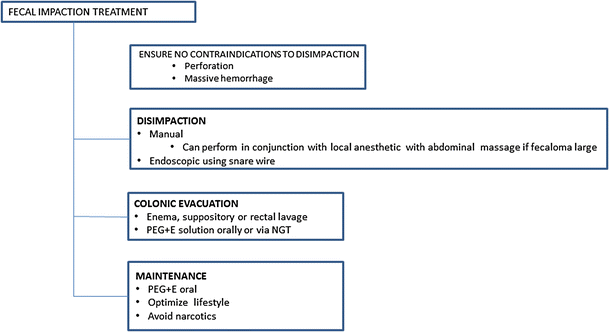Does Miralax Work for Impacted stool? Gastroenterologist explains.
Our content is not intended nor recommended as a substitute for medical advice by your doctor. Use for informational purposes only.
What you need to know.
Miralax works for fecal impaction only after the dis-impaction using mineral oil enema or manual impaction. Using MiraLax before removing the impacted stool mass might not work and may cause a worsening of the condition.
You can use MiraLax (PEG) in severe constipation (without impaction) or early mild stool impaction.
However, vomiting, severe abdominal distension, and abdominal colics can complicate the early use of MiraLax in severe cases of impaction (with a large hard stool mass in the rectum).
Either way, You have to consult your doctor. Fecal impaction is a serious medical condition. The trial to disimpact stool by yourself may lead to failure or complications.
Confirming fecal impaction.
The decision to use MiraLax depends on the confirmation of your condition. It is important to know the difference between severe constipation and fecal impaction.
Symptoms of stool impaction:
- History of long-term severe constipation.
- Previous history of stool impaction.
- Presence of risk factors such as older age, prolonged bed recumbency, and some medications such as narcotics and anticholinergic drugs.
- Lower abdominal pain and distension with a persistent urge to poop (sometimes, the urge is absent in the elderly or patients with debilitating diseases).
- Leakage of liquid stool material around the impacted mass (causing false diarrhea).
- Straining with intense urge, but nothing comes out.
- In some cases, rectal bleeding, lower back pain, and loss of bladder control.
- In extreme cases, symptoms of intestinal obstruction may occur, such as severe abdominal distension and persistent vomiting.
Stool impaction is difficult to diagnose.
Both patients and doctors can easily overlook stool impaction. Early diagnosis of stool impaction helps easier dis-impaction.
Early-stage stool impaction is similar to severe constipation in symptoms. Only your doctor can know the difference by:
- Performing a rectal exam (to detect the stool mass in the rectum).
- However, the stool impaction can be higher in the sigmoid (cannot be detected by rectal exam).
- So, if your doctor still suspects fecal impaction, he will order an abdominal radiograph to diagnose the condition.
The most important step before using Miralax for impacted stool.
Treatment of stool impaction must pass in these three steps in order (reference).
- Disimpaction: Manual, endoscopic, or special tools to break down and disimpact the stool mass.
- Colon Evacuation: by enema (mineral oil), suppositories, Oral MiraLax (can also be given via nasogastric tube).
- Maintenance (prevention of recurrence): Long-term MiraLax (Polyethylene glycol), avoiding narcotic medications, and improving your lifestyle.

(Reference: Hussain, Z.H., Whitehead, D.A. & Lacy, B.E. Fecal Impaction. Curr Gastroenterol Rep 16, 404 (2014)).
In severe cases of stool impaction, MiraLax cannot be used as the first step of treatment.
Your doctor or nurse must first disimpact the hard stool mass (either by gloved finger or by special tools). Then, MiraLax can be given to help evacuate the stool remnants inside the colon.
Don’t try to use higher doses of MiraLax for stool impaction without medical supervision.
The dose and the method of MiraLax for Fecal impaction.
After the disimpaction of the stool mass, a large dose of MiraLax (polyethylene glycol) should be given.
Use MiraLax as directed by your doctor or as follows (reference):
- The preferred dose is 17 grams of MiraLax® once daily.
- Measure your dose with the medicine cap on the bottle.
- Pour the powder into 4-8 ounces of beverage.
- The beverage can be a cold or hot one.
- For example, Water, Juice, Soda, coffee, or tea.
- Your doctor may give you MiraLax (combined with mineral oil enema) during disimpaction.
- Your doctor may prescribe MiraLax after the disimpaction for long periods to prevent its recurrence.
DON’T:
- Use MiraLax if you’re pregnant or lactating unless prescribed by your doctor (generally considered safe, Not assigned to a category by the FDA).
- Don’t Use with suspected bowel obstruction (Before disimpaction of the stool).
- Use for more than a week without permission from your doctor.
- Use MiraLax if you experience severe abdominal distension or vomiting.
Related:
- How do you know stool impaction has cleared?
- Can you take Miralax 3 times A day?
- Impacted Stool: Treatments & Best Laxative, A Doctor’s Top Tips.
What to do if MiraLax fails to work for impacted stool?
The first step after manual or endoscopic disimpaction of the stool is to identify the cause of constipation.
Then, treatment of this underlying cause and using laxatives (such as MiraLax®) to evacuate the colon and prevent a recurrence.
Stool impaction usually affects people with Risk factors such as (reference):
- Poor diet, low fiber intake, or dehydration.
- Immobility, bed-ridden debilitated patients.
- Strictures of the rectum or sigmoid colon.
- Medications include opioids, ant-cholinergic drugs, and some anti-hypertensive and anti-depressant medications.
- Analifissures and fistulas.
- Mechanical obstruction by a tumor or mass.
- Neurological diseases include Parkinson’s, Alzheimer’s, spinal cord injury, and cerebral palsy.
In certain cases, the cause may be severe (such as neurological diseases and structures). This may cause MiraLax® to fail in restoring bowel movements.
Consult your doctor if MiraLax doesn’t Produce bowel movements for three days or more. Your doctor will:
- Evaluate your clinical history and examine to detect the cause of constipation and non-response to MiraLax®.
- Stop any medications that induce constipation or stool impaction.
- Perform a colonoscopy or order some investigation, such as abdominal imaging.
- Adjust the dose of MiraLax, add another medication, or replace MiraLax with another laxative.
- Treat the cause, such as structures oranal fissures.
- In severe cases of fecal impaction, Abdominal massage with local anesthesia may help to relax the analcanal and pelvic floor muscles.
- Prescribe enemas, Biofeedback, or newer anti-constipation agents.
LEARN MORE:
The Dose of MiraLax for severe constipation.
My poop is too big to come out, and hurts: What to do?
- Evidence-based
- Written by a doctor.







